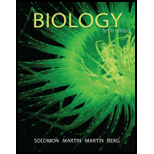
Concept explainers
The genome of a virus consists of (a) DNA (b) RNA (c) prions (d) DNA and RNA (e) DNA or RNA
Introduction: An organism which has the characteristic feature to reproduce inside the living cell is called “virus”. They can survive without the host for a long period of time. When they infect the host cell they use the cell machinery of the host to reproduce. The size of the virus is extremely small and varies from 20 to 300 nm. The wide area of Earth is occupied by the viruses.
Answer to Problem 1TYU
Correct answer: The viral genome consists of deoxyribonucleic acid (DNA) or ribonucleic acid (RNA). Hence, the correct answer is option (e).
Explanation of Solution
Reason for correct answer:
Viral genome can be DNA or RNA, but it cannot be both at the same time. The virus can have single stranded or double stranded genome. This makes the virus classified into four categories: ss DNA, ds DNA, ss RNA, and dsRNA. Viruses can possess only a single type of genome at a time. Thus, the virus consists of either DNA or RNA.
Option (e) is given as “DNA or RNA”.
The virus can have either “DNA or RNA” as its genome. Hence, the correct answer is option (e).
Reason for incorrect answer:
Option (a) is given as, “DNA”.
Some of the viruses also possess RNA as their genetic material. This means some of the viruses still carrying RNA as their genome. Hence, option (a) is incorrect.
Option (b) is given as, “RNA”.
There are a variety of species still exists which consist of DNA as their genome. This signifies that the variety of viruses are having different genetic material other than RNA Hence, option (b) is incorrect.
Option (c) is given as, “prions”.
A prion is an organism which does not affect by any radiation and the presence of either DNA or RNA was not found in them. Thus, such a structure cannot be considered as the genome. Hence, option (c) is incorrect.
Option (d) is given as, “DNA and RNA”.
Viruses cannot possess both DNA and RNA as their genome at the same time. They can have either DNA or RNA in their genome. Thus, both of these genomic materials cannot be considered as genetic material in viruses. Hence, option (d) is incorrect.
Hence, the options (a), (b), (c), and (d) are incorrect.
The genome of the virus can have either “DNA or RNA” at a time.
Want to see more full solutions like this?
Chapter 24 Solutions
Biology (MindTap Course List)
- What symbolic and cultural behaviors are evident in the archaeological record and associated with Neandertals and anatomically modern humans in Europe beginning around 35,000 yBP (during the Upper Paleolithic)?arrow_forwardDescribe three cranial and postcranial features of Neanderthals skeletons that are likely adaptation to the cold climates of Upper Pleistocene Europe and explain how they are adaptations to a cold climate.arrow_forwardBiology Questionarrow_forward
- ✓ Details Draw a protein that is embedded in a membrane (a transmembrane protein), label the lipid bilayer and the protein. Identify the areas of the lipid bilayer that are hydrophobic and hydrophilic. Draw a membrane with two transporters: a proton pump transporter that uses ATP to generate a proton gradient, and a second transporter that moves glucose by secondary active transport (cartoon-like is ok). It will be important to show protons moving in the correct direction, and that the transporter that is powered by secondary active transport is logically related to the proton pump.arrow_forwarddrawing chemical structure of ATP. please draw in and label whats asked. Thank you.arrow_forwardOutline the negative feedback loop that allows us to maintain a healthy water concentration in our blood. You may use diagram if you wisharrow_forward
- Give examples of fat soluble and non-fat soluble hormonesarrow_forwardJust click view full document and register so you can see the whole document. how do i access this. following from the previous question; https://www.bartleby.com/questions-and-answers/hi-hi-with-this-unit-assessment-psy4406-tp4-report-assessment-material-case-stydu-ms-alecia-moore.-o/5e09906a-5101-4297-a8f7-49449b0bb5a7. on Google this image comes up and i have signed/ payed for the service and unable to access the full document. are you able to copy and past to this response. please see the screenshot from google page. unfortunality its not allowing me attch the image can you please show me the mathmetic calculation/ workout for the reult sectionarrow_forwardIn tabular form, differentiate between reversible and irreversible cell injury.arrow_forward
 Biology (MindTap Course List)BiologyISBN:9781337392938Author:Eldra Solomon, Charles Martin, Diana W. Martin, Linda R. BergPublisher:Cengage Learning
Biology (MindTap Course List)BiologyISBN:9781337392938Author:Eldra Solomon, Charles Martin, Diana W. Martin, Linda R. BergPublisher:Cengage Learning Biology Today and Tomorrow without Physiology (Mi...BiologyISBN:9781305117396Author:Cecie Starr, Christine Evers, Lisa StarrPublisher:Cengage Learning
Biology Today and Tomorrow without Physiology (Mi...BiologyISBN:9781305117396Author:Cecie Starr, Christine Evers, Lisa StarrPublisher:Cengage Learning Biology: The Dynamic Science (MindTap Course List)BiologyISBN:9781305389892Author:Peter J. Russell, Paul E. Hertz, Beverly McMillanPublisher:Cengage Learning
Biology: The Dynamic Science (MindTap Course List)BiologyISBN:9781305389892Author:Peter J. Russell, Paul E. Hertz, Beverly McMillanPublisher:Cengage Learning Concepts of BiologyBiologyISBN:9781938168116Author:Samantha Fowler, Rebecca Roush, James WisePublisher:OpenStax College
Concepts of BiologyBiologyISBN:9781938168116Author:Samantha Fowler, Rebecca Roush, James WisePublisher:OpenStax College





